Can I Use Windex on Stainless Steel? No & Why
Author: Anne Cowart | Editor: Omar Alonso
Review & Research: Jen Worst & Chris Miller

Do you have a stainless steel fridge? If you accidentally spilled something on the door and it dried and stained, you might find it challenging to remove it. You rub it off with a wet rag, but there’s still a faint outline noticeable if you stare at it. Then you start to wonder... can you use Windex on stainless steel?
Since you’re cleaning the windows right now and the Windex seems to remove tough stains from the glass, you might wonder if you can use Windex on stainless steel to clean the fridge door. While several multi-purpose cleaners are ideal for cleaning brushed stainless steel surfaces, like the fridge door, we don’t recommend you try and clean it with Windex.
This post unpacks everything you need to know about Windex and its effects on stainless steel. We’ll also give you an alternative to clean the surface without damaging it.
What Is Windex & How Do I Use It?
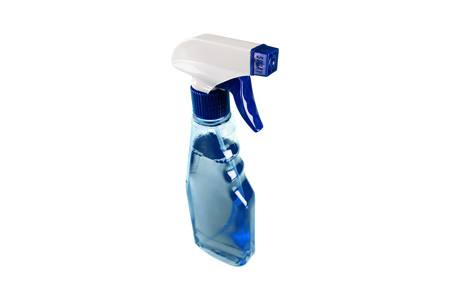
Windex is one of the top-selling multi-surface cleaners in America and millions of homeowners trust it to leave their windows sparkling clean. While most people assume it’s only suitable for cleaning glass, the reality is it’s a great multi-purpose cleaner with several applications around the home. Just don’t use it on your stainless steel appliances. Glass cleaner on stainless steel is a big no due to the ammonia content.
What are the Properties of Stainless Steel?
Stainless steel is one of the most durable materials on the planet with thousands of home and industrial applications. It differs from carbon steel due to it being an alloy steel.
Manufacturers mix the steel with another metal, chromium, during the manufacturing process. Adding chromium to the steel makes it stronger and corrosion resistant. The average 304L grade of stainless steel has 200X more chromium in it than carbon steel, making it highly corrosion-resistant and ideal for all-weather use.
Stainless steel also has properties like excellent temperature resistance, high strength and durability, and low maintenance. It’s easier to form in manufacturing applications and has a shiny, attractive appearance, which is one of the reasons its so popular in appliance manufacturing.
After placing stainless steel into service, you don’t need to treat or coat the surface thanks to its weather-resistant and corrosion-resistant properties.
What are the Grades of Stainless Steel Used in Appliance Manufacturing?
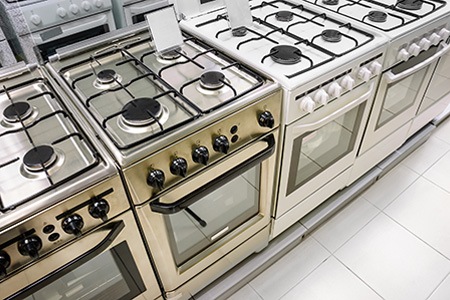
Stainless steel comes in more than 150 grades, describing its physical properties, composition, and applications. The most common series are 200, 300, 400, 600, 900, and 2000. 304 and 316 are the most popular for industrial applications, while the 400 Series is commonly used in cutlery manufacturing, razor blades, and surgical steel.
The 900 series is ideal for industrial applications and it’s so resilient its resistant to most acids. However, it’s far more expensive than the 300 and 400 Series, and only found in industrial use.
What are the Results of Using Windex on Stainless Steel?
Windex is known as an “ammonia-based” household cleaner. According to stainless steel specifications, homeowners should never use it in cleaning applications as the ammonia can damage the steel. However, some people recommend using other non-ammonia based window cleaners because they provide a sheen and shine to the metal, restoring its original look.
Windex does offer an ammonia-free cleaning product, so you could theoretically use it to clean your stainless steel appliances. However, you’ll have to inspect the labels to see if that’s the product you have in your kitchen cabinet.
Can I Remove Stains on Stainless Steel With Windex?
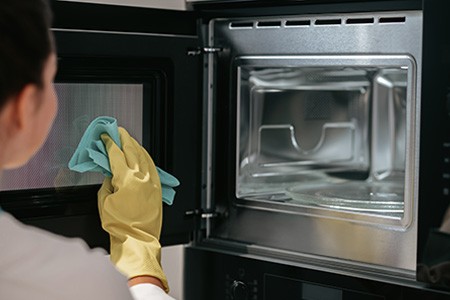
Windex is effective as lifting stubborn stains from glass and a range of surfaces around the home. It can surely lift the stain on your stainless steel appliance, but the after effects might not be worth the risk of using it for this task.
However, you can check if the Windex interacts with the stainless steel by using the spot-test method. Pull the fridge out and spray a small section on a piece of the stainless steel siding that out of view. Rub it and dry it with a cloth. Leave it for a day and look at it again.
If it looks fine, you shouldn’t have any issues with using the Windex to lift the primary stain. If there’s discoloration in the stainless steel surface, don’t use the Windex to remove the stain. Remember to test it. I had a friend who sprayed a spider with Windex on their stainless steel fridge door and it still is discolored to this day.
Homemade Cleaning Solutions for Stainless Steel
While using Windex to remove stains from stainless steel appliances isn’t the move, there are several products that can do the job without damaging the surface. Homemade cleaners are ideal for this task, and you won’t have to worry about them causing any discoloration on the appliance.
Olive oil, vinegar, and even flour are all ideal for cleaning stains on stainless steel appliances. Most stains will wipe away from stainless steel surfaces without the need for anything more than water. However, these household cleaners offer an alternative solution if that strategy doesn’t produce results.
Recommended Cleaners for Stainless Steel
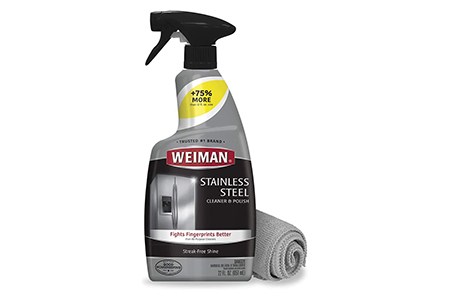
Research online for the best cleaners available to clean stainless steel surfaces. Some of our top recommendations include Weiman Stainless Steel Cleaners and Stainless Steel Cleaning Wipes. These products leave stainless steel surfaces looking as good as new, but they cost far more than the homemade alternatives mentioned above.
Take Caution When Using These Cleaners on Stainless Steel
Can you use Windex on stainless steel? No. Along with Windex, there are several other cleaning agents you should avoid using on stainless steel appliances. Never try to clean them with the following:
- Baby oil
- Club soda
- Rubbing alcohol
- Mineral oil
- Bleach
These cleaning products interact aggressively with stainless steel, exacerbating the problem. So, you’ll end up with a bigger stain than when you started, resulting in huge problems if you want to resell the appliance sometime down the road.
Most inert oils, like olive oil and sunflower oil are okay for the task, but they leave a greasy surface and require cleaning afterward. Our favorite household alternative is vinegar. Vinegar is a powerful natural cleaning agent and you’ll find it lifts the stain easily.
After you remove the stain, wash the cleaned area with dish soap and water, then dry it and you’ll find the surface looks as good as new. So, can you clean stainless steel with Windex or any other mentioned cleaner? No!
Avoid Using These Scrubbing & Wiping Materials on Stainless Steel
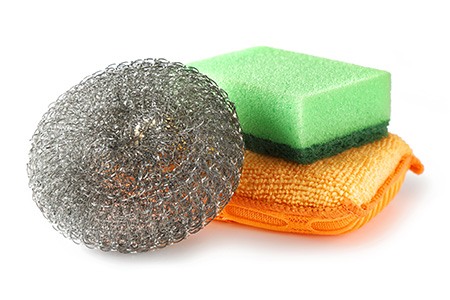
Along with the cleaning agents mentioned previously, you should avoid using the following applicators when cleaning stainless steel surfaces. While stainless steel is resilient and scratch-resistant, using steel wool or pot scourers and abrasive sponges on the surface will leave fine scratches. There are ways to remove scratches from stainless steel as long as they aren't deep gouges.
While most kitchen products feature construction with “brushed” stainless steel, that doesn’t mean they can withstand the aggressive cleaning action of these applicators. Only clean stainless steel with a soft rag or microfiber cloth.
How Do I Clean Stainless Steel Appliances?
Can you use Windex on stainless steel? No, so what are the options? If you have to get rid of those unsightly stains on the fridge door, start by filling a bucket halfway with lukewarm water. Add three or four tablespoons of white spirit vinegar and mix well. Dip a rag or soft cloth into the bucket, saturate it and wring it out.
Gert to work on cleaning the stain. However, don’t press too hard on the area. Most fridge doors only feature a thin sheet of stainless steel on the exterior., Pressing on the surface with force may end up denting the door, ruining its aesthetic.
Stainless Steel Decor
Appliances are the most commonly stained items involving stainless steel construction. It’s a popular trend in kitchen design to use this material in appliance construction and we all know how messy the kitchen gets.
However, there are several other things around the house that could be made from stainless steel and experience staining. Even though stainless steel is waterproof, decor items can get stained if they come in contact with water, food or beverages. You can clean these items using our previous guidelines using vinegar and a soft cloth.
Stainless Steel Surfaces

Kitchens usually have sinks and flatware and silverware that get stained with water spots, food, and beverages. Use the vinegar solution and soft cloth to wipe them away. If the stainless steel looks dull after cleaning, you can spruce it up using the specialized stainless steel cleaning items mentioned earlier. Stainless steel is generally waterproof if you take care as explained here.
Stainless Steel Crockery & Cookware
Stainless steel crockery and cutlery may experience water spots after being in the dishwasher and drying. Can Windex be used on stainless steel? No, don’t wipe them down with ammonia-based surface cleaners like Windex.
Not only will it discolor the surface, but the chemicals in the cleaners leave behind a residue that toxic for human consumption. You don’t want to end up getting an upset stomach just because you wanted to clean your knives, forks, pots and pans.
Stick to traditional cleaners, like dish soap and buff the steel after washing to give it a shine. These cleaners don’t leave behind harmful residues and they’re effective at removing stains and water spots from stainless steel.
So, Can I Use Windex on Stainless Steel Appliances in My Home?
If you have the ammonia-free version of the product, you can probably get away with it. However, we recommend sticking to inert cleaners, such as vinegar. Always remember to clean with a soft cloth to avoid scratching the surface.
Avoid using multi-purpose cleaning agents on stainless steel, especially those continuing ammonia or bleach. So can you use Windex on stainless steel? No, it is ammonia-based. These ingredients damage the steel, discoloring it. If the stain is stubborn, buy in a specialized cleaning product for the task.




